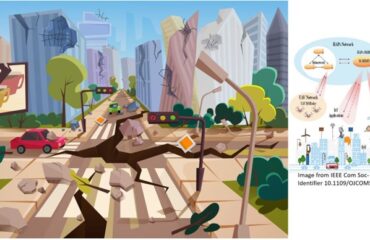Why is 5G so Important and How It Will Transform the Society
5G promises to bring about a technological revolution, but what can it really do for us?
Read on to discover the importance of 5G and how this technology will transform our world we live in.
Why is 5G so Important and How It Will Transform Society?

With the current rate of technological growth, the fifth generation mobile network, 5G, is one of the major technological innovations certain to transform our world. It has the ability to link everyone, offer high speed connectivity, and revolutionize the way we think about mobile devices.
The world is ready to undergo extraordinary changes thanks to 5G. Understanding how 5G technology is anticipated to serve as the core of the future digital economy and how it will help in addressing social issues will allow us comprehend why we need it. Let’s have a look what 5G networks are and how they affect society.
What is 5G?
The fifth generation of cellular, wireless, mobile networks is known as 5G. It is up to 100 times quicker than 4G and is giving consumers and companies’ access to markets they have never had before. Greater bandwidth, low latency, and superfast connectivity are revolutionizing industries, expanding communities, and vastly improving day-to-day interactions. Services like e-health, interconnected cars and traffic systems, and improved wireless cloud gaming that were once thought to be futuristic are now available.
People can contribute to building a brighter, safer, and more secure future using 5G technology. Imagine having video conference sessions without any delays or technological issues. Imagine being at a concert with large numbers of attendees yet still receiving outstanding cell phone coverage for calling, video streaming, and using internet-based applications like social networking. Thanks to 5G, such a world has come to exist.
Consumers will be able to safeguard their data and privacy with 5G, which will also make it possible for more sophisticated applications to access more information and data. Users can manage their personal details, including privacy and access control. It will dramatically change how we utilize the internet while safeguarding our privacy.
The very same radio frequencies that are commonly utilized for satellite communications, your smartphones, and Wi-Fi networks also support 5G, but it allows for much greater technological advancement. 5G is truly about connecting devices everywhere, consistently, without interruption, so that humans can measure, analyze, and control things in real time.
This goes beyond just being able to download an entire HD movie to your smartphone in a matter of seconds. It is indeed moving to a new level and has tremendous potential. Another justification for the necessity for 5G technology is the possible societal implications. Although 5G’s fundamental capabilities are simple to comprehend, there are numerous and varied ways that the next-generation system could assist in resolving long-standing social issues.
The way we live will be completely changed by 5G networks. New forms of human-communication with machines will be made possible by technology. The majority of facets of daily life, such as transportation, electricity, and manufacturing, would be impacted. According to estimates, 5G could improve network capacity by 40 times over 4G.
The impact of 5G could be felt across a number of different businesses. Companies in the industrial, construction, or utilities sectors will be able to connect via existing infrastructure. By switching from 100 megabits per second to 10 gigabits per second links, data centers might free up system resources for other uses. Let’s explore how this technology will change the world in the future.
How Will 5G Transform the Future?
1. Smart Cities
A relatively new idea that will be supported by 5G is the smart city. This entails that all of the city’s infrastructure is interconnected to offer improved services like public transport services, lighting control, fuel efficiency, and others. Energy will be saved in smart cities, which are believed to be more environment friendly. Citizens will also save money as a result of this.
Smart cities will depend on AI-enabled urban administration technologies with complete confidence. Citizens can tweet, post images, and send notes to the system for any issues with the infrastructure of smart cities.
It will deploy a maintenance team to fix any issues in a couple of seconds. A prime example is the sewage system that can detect spills. Over the network, it will quickly notify the control room, and the problem will be immediately fixed by the control room.
Furthermore, 5G might support linked gadgets that can track crop performance, smart cities that employ IoT sensors to track air quality and enhance traffic conditions and junction safety, and hospitals that can virtually diagnose and treat patient discomfort with hands-on treatments. In this situation, drones are also evolving into a crucial tool for facilitating and speeding up emergency response.
2. Smart Vehicles
5G has the potential to revolutionize the transportation industry. The technology that enables automobiles and infrastructure to interact with one another is known as vehicle-to-everything communication (also known as V2X).
Governments have already been working towards this objective for a long time, but the majority of the research has concentrated on vehicle-to-roadway communication. With the help of V2X, vehicles such as trucks and cars may interact with one another and with intelligent infrastructure, like traffic lights, enhancing safety, and reducing congestion. This could increase the effectiveness of the entire transportation network.
Additionally, V2X enables automobiles to alert drivers about potentially hazardous situations that they have identified, such as an approaching collision. Additionally, it enables vehicle sensors to alert a traffic light ahead of congestion, enabling the signal time to be modified appropriately.
V2X can provide expanded communication between cars and the infrastructure supporting traffic, enabling more effective traffic routing. With the help of V2X, smart intersections will be developed in the future that permit several cars to pass through simultaneously without having to stop.
Additionally, automated vehicles will offer automated transportation services. The creation of a complete network of automated transportation services is still constrained. The growth of these services will be largely dependent on 5G networks. It is well recognized that an automated automobile will not have a human driver.
There are two stages to the development of these smart automated vehicles. The beginning of automated transport service systems is the initial stage. Only a small number of automobiles will be a part of the system at this time. The creation of fully automated automobiles will be the second stage. In this scenario, the vehicles will be able to drive wherever they want to, safely.
3. Smart Buildings
The human race will be able to profit much from 5G connection in terms of smart buildings. It will enable us to have control over our environment. Based on how many individuals are inside, controlling the airflow or setting the ideal temperature in buildings will be done in the blink of an eye with this technology. With 5G, we can more easily incorporate actuators and sensors into our current infrastructure systems. In this way, living conditions and quality of life can be enhanced while operational costs are cut down. Upcoming housing developers and architects are already taking 5G into account for building designs and construction.
A wide range of radio frequencies are covered by 5G. For instance, certain frequencies allow for long-distance networking inside of a building. For smart buildings, for instance, that will enable the connection of wireless sensors and actuators.
Extremely high frequencies allow improved applications such as 4K and 8K video streaming as well as pinpoint location precision. This guarantees a seamless internet connection for video chats at work. Additionally, a building’s operational technology will be quicker and more dependable.
Continuously monitoring video surveillance systems would be able to deliver high-quality videos. Sensors that detect occupancy can tell when lights are needed or the air conditioner needs to operate more quickly.
Network slicing is another feature which can be used with this new wireless technology. The 5G infrastructure is virtualized, allowing multiple systems to share it. A fire system and a building automation system, for instance, can share a network. Both systems will meet the requirements for bandwidth and alarm delay.
Smart Grids will also develop to incorporate both the provision of electricity and smart buildings as we go into the new era of 5G. According to this idea, distributed renewable resources are integrated into the Smart Grid for efficiency. A smart building may also incorporate other environmentally friendly technology such as geothermal heaters or water harvesting, as well as solar power to generate its very own electricity.
The Smart Grid will help in lowering energy costs. The Smart Grid can lower prices by 25% as electrical power becomes more productive. The reduction will be achieved by utilizing renewable energy sources like solar and wind more frequently.
4. Transformation of Industries
5G lays the groundwork for flexible, effective, and ethical business. It is intended to have very little latency, lots of bandwidth, and a huge amount of throughput. To satisfy the needs of oil drilling and production in real time, all of these characteristics are required.
A sophisticated data processing system for observing and managing the procedure of drilling for oil and natural gas can be created with the help of 5G. It can be used to generate digital replicas that can foresee real mechanical failures.
Additionally, it is simple to achieve complete traceability at docks and warehouses for an individual item. Usually, attached communication cables are used by equipment in automated warehouses like conveyors, sorters, and truck unloaders.
That gear will be released by 5G so that it is no longer constrained and can be configured in the best way possible to increase productivity. Warehouses are safer thanks to the absence of delay. Adjustments will be made in real time even if the operator is controlling the machinery from a different part of the world.
Additionally, the speedier transaction processing made possible by 5G would speed up the consumer’s acceptance of digital payments and, consequently, increase industry owners’ profits. The ability to process payments anytime and anywhere, will increase convenience for customers. New payment services and IoT applications will have a future thanks to improvements to the payment infrastructure brought about by 5G.
5. Connecting Employees is much easier
Through 5G technology, communications will be transformed completely. Workers will be dependent on technology as sectors continue to undergo digital transformation. Internet-based technologies and gadgets are now more accessible to various points and systems, thanks to 5G connectivity.
For example, communication with a back-end system located somewhere in the cloud from a tablet or smartphone will be much faster and significantly more dependable by using 5G.
Consider a few examples of mobile applications that field employees need access to, like video conferencing with specialists and coworkers and real-time access to data through augmented reality and VR (virtual reality) platforms. Additionally, those activities must provide a positive user experience and be secure, all of which will be achievable with 5G.

6. Expansion of Utility Possibilities
To satisfy their consumers, utilities will be able to rapidly add new functionalities with 5G. A strong, secure IoT network will be available for connectivity thanks to wireless technologies. Energy businesses will be able to optimize operations as a result.
Additionally, it will make it simpler to integrate smart meters, which is a new form of enhanced metering. By adapting the electricity grid’s machinery to current technologies, it will also hasten grid modernization. Utilities will be able to use real-time information from a device to the internet, thanks to 5G. As a result, energy resources will be automated and optimized more effectively, enhancing resilience and providing clients with more insightful data to lower their energy consumption.
7. Agriculture
Every industry, including agriculture, will undergo a revolution thanks to 5G. Rural locations can get dependable internet through 5G. It will enable more efficient agricultural output and full control over the environment. The farmer will be able to fully utilize remote sensor systems and real-time crop, land, and weather monitoring with 5G.
Additionally, 5G will enable farmers to virtually use advanced farming measures to safeguard the environment, such as combining smaller farms into bigger ones and precision farming. By hastening the planting, developing, and harvesting operations, production cycles will be considerably shorter.
8. High standard of Living for Disabled People
People with impairments will be able to use the internet at a reasonable price with 5G. By facilitating communication and offering faster and more adaptable broadcasting of media and services, it will enhance daily living. People may be able to function in society and be liberated from the sensation of isolation as a result.
Smart machines and wheelchairs can be integrated using 5G, which will make disabled and handicapped people move around with more confidence and ease. The way we link disabled people to resources and content needs to be innovative if we want to realize their full potential.
In order to do this, we must include more individuals with disabilities in the global discussion about accessibility, their requirements, and also how 5G can assist them.
9. Medicine and Health
The healthcare industry and medical research will undergo a full revolution thanks to 5G. It will accelerate the advancement of cutting-edge medical research for cancer therapy and genetic disorders. Additionally, 5G will enable more advanced medical devices with greater capabilities, such as heart monitoring of patients.
Additionally, it will make cheaper, more effective medical devices based on satellites possible. A few uses for 5G include remote monitoring and control using high-resolution imaging and real-time data gathering, telemedical counseling, remotely produced clinical trials, remote telesurgery in a completely isolated surgery room, and rural access to specialized care and treatments.
These are all excellent illustrations of telemedicine services that might be provided with 5G technology.
10. Robotic Applications
The field of robotics and drones will have a plethora of options with the launch of 5G. It is possible to have your robot vehicle travel around without bumping into obstructions in its path. It is also the most recent and excellent possibility to use artificial intelligence in robotics.
With 5G, drones may serve as intermediaries for connections between various devices, and over-the-air upgrades are a possibility as well. These will play a significant role in allowing updates to be given to robots with extraordinary speed and precision.

Final Verdict
One of the most significant technological advancements of the subsequent years will be 5G. It will serve as the basis for industrial automation, connected homes and automobiles, automated manufacturing, smart cities, and much more.
Organizations should make sure they remain at the forefront of technological transformation by recognizing the value of 5G technology and making proactive investments in 5G-ready technologies.



